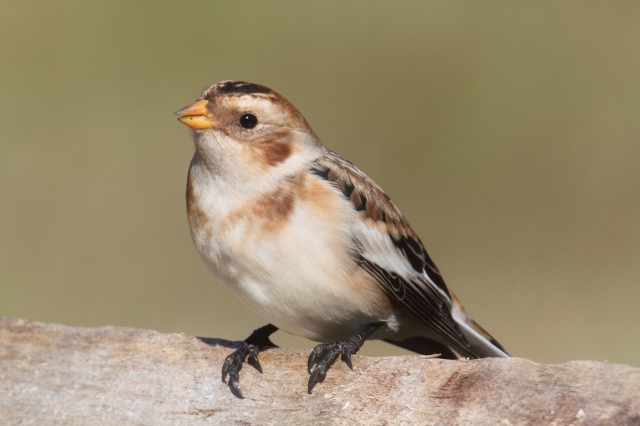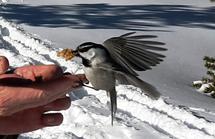saveourplanetearth.com
Call us: (775) 831-1331
How do Birds Stay Warm?
One thing I always think about as I watch the birds that flock to my feeders in the wintertime is, how do these small creatures survive the Tahoe area’s cold temperatures and snowstorms?
Take the snow bunting, for example, which as we already learned, does not come down from the north as far as Lake Tahoe, in any season.
The snow bunting is the northernmost songbird in the world and apparently conditions at Lake Tahoe are too mild for its taste, even in the winter. Wintering grounds for the snow bunting include Minnesota and Montana and if you’ve ever been to those states in the winter, you know how cold that is, as in, very cold.
The snow bunting is white on its underparts, with white, brown and black wings. The feathers of this and all birds are incredibly insulating against the cold, or heat, as the case may be. Feathers are oily, providing further insulation and waterproofing.
The snow bunting also has feathered legs, making it better suited to the cold. The bunting builds nests on the ground, in crevices which provide shelter from the elements and predators. These birds are breeding in subzero temperatures so the female remains on the nest while the male hunts.
After breeding season in the Arctic, beginning in September or as late as November, the snow bunting makes his way to “warmer” climes for the winter, such as that found in North Dakota and similar areas.
Before migrating back to the Arctic in the spring, he has to gain 30% of his body mass. The bunting migrates nocturnally, and does so by detecting the geomagnetic field of the earth, rather than visually. Studies have shown that only individuals with adequate energy storage are able to select seasonally appropriate directions during migration.
Birds at Lake Tahoe and elsewhere grow extra feathers in the fall to provide additional insulation for the coming winter months. The bird’s legs and feet are covered in scales designed to minimize heat loss.
In the fall, birds begin to gather into flocks for travel and roosting, clumping together at night to share body heat. They may group together in small spaces or against the trunks of trees to take advantage of the heat absorbed by the bark during the light of day.
Birds will fluff out their feathers to create air pockets for further insulation and will also generate heat by shivering. Shivering consumes calories so a bird needs to be well fed during the cold months.
Birds need high fat, high energy foods in the winter such as black oil sunflower seed and suet. Even though there is snow on the ground, it takes precious energy to consume it so an open source of water, perhaps in a heated bird bath, is a bonus for the birds.
Locals and visitors alike enjoy feeding the chickadees at the meadows on the summit of Mount Rose Highway. Jacquie Chandler, who hosts a vacation rental property, has a list of activities for her guests during their stay and the friendly chickadees are a favorite.
Jacquie offers appropriate seed and treats for the guests to bring. One of her guests snowshoeing at the meadows was eating an English muffin spread with peanut butter when a chickadee landed on his head. The bird then alit on his hand, helping himself to some of that muffin.
As any good Lake Tahoe resident knows, we should not be feeding the wildlife, and this includes birds, yet still we do. I’ve been putting out wild bird seed, thistle, sunflower seed, peanuts and suet for probably 20 years.
If you do put out feeders for the birds, make sure to bring them in at night so as not to attract bears, even in the winter.
There are downsides to feeding the birds. Supplemental feeding of the birds can cause advanced laying dates in the spring and may give an advantage to backyard birds over other species that may already be threatened. And of course, the congregation of birds at backyard feeders increases the potential for the spreading of disease.
Even with the bag of survival tricks, birds can succumb to the cold so I will continue to aid the avian visitors with a high-energy meal and hope that I’m not doing more harm than good.
Snow bunting
canstockphoto.com
Mountain chickadee
Photo: Jacquie Chandler




